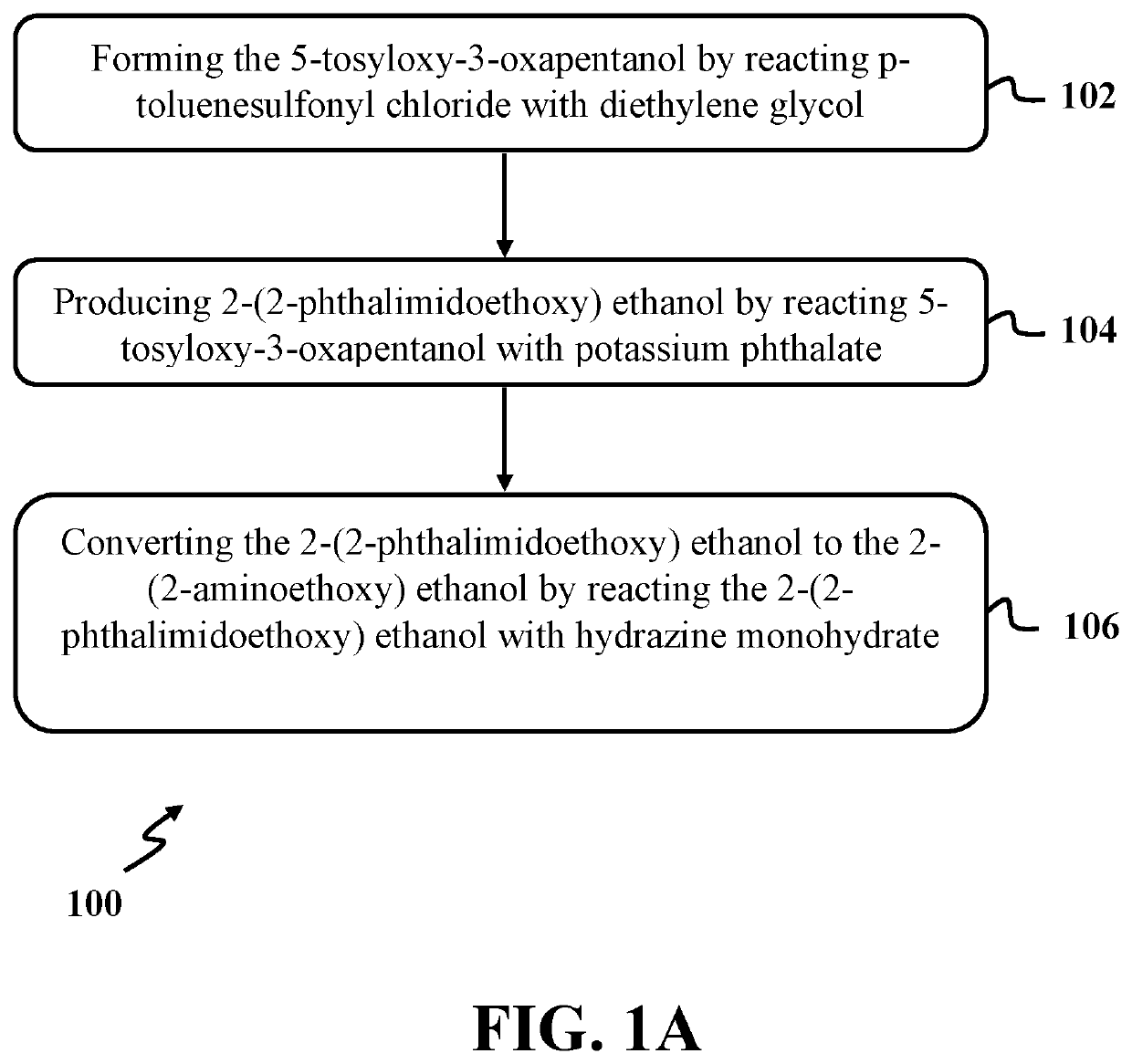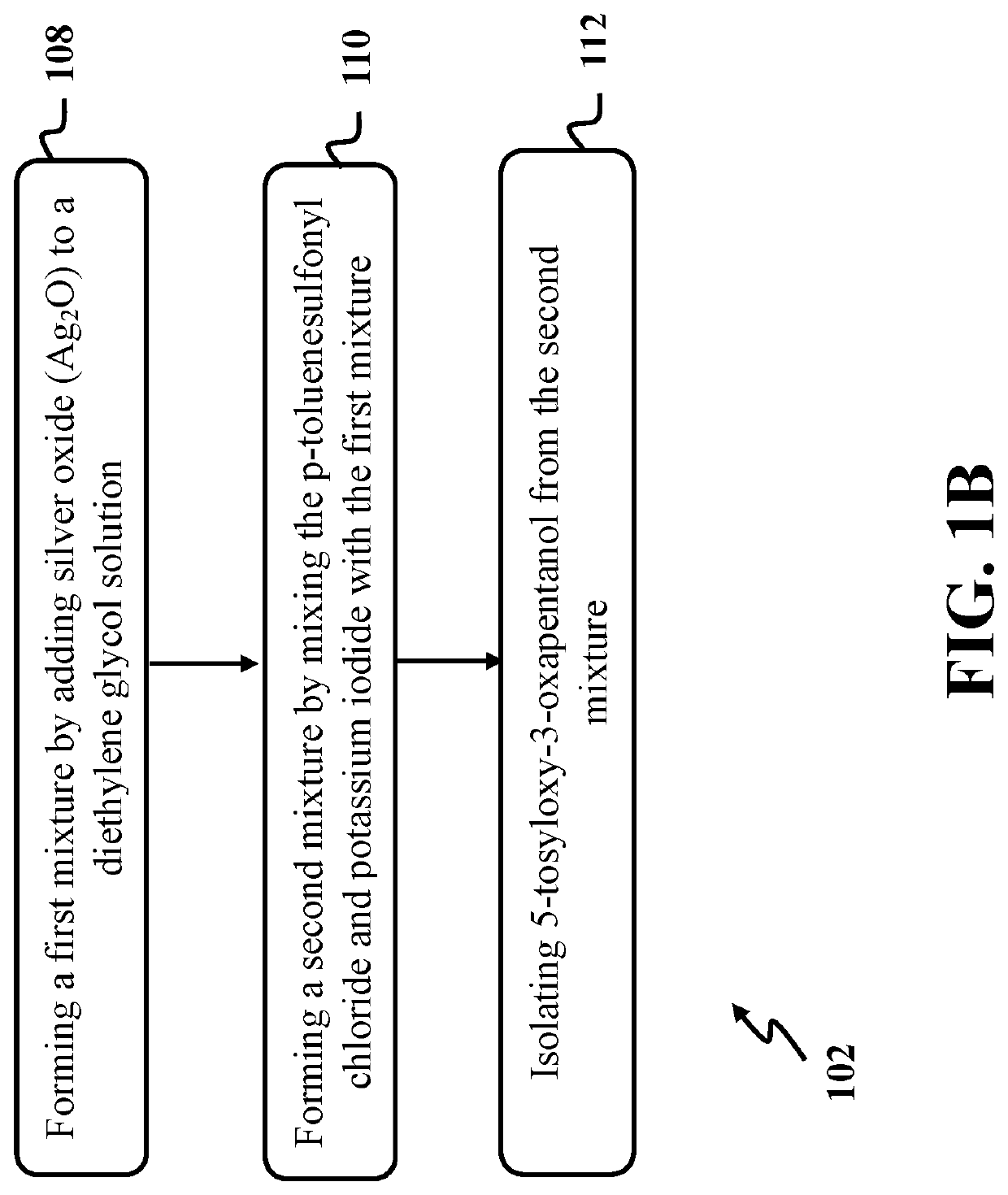Synthesis of 2-(2-aminoethoxy) ethanol
a technology of 2-(2-aminoethoxy) ethanol and synthesis method, which is applied in the preparation of organic compounds, sulfonic acid esters, and amino-hyroxy compounds, etc., can solve the problems of limiting the industrial applicability of conventional methods, and low yield of conventional methods
- Summary
- Abstract
- Description
- Claims
- Application Information
AI Technical Summary
Benefits of technology
Problems solved by technology
Method used
Image
Examples
example 1
-Tosyloxy-3-Oxapentanol Using Diethylene Glycol
[0055]In this example, 5-tosyloxy-3-oxapentanol was formed by reacting p-toluenesulfonyl chloride with diethylene glycol utilizing a process similar to step 102 of exemplary method 100 as presented in FIG. 1. At first, a solution of diethylene glycol with a concentration of about 0.1 M was formed by dissolving about 1.5 mmol of diethylene glycol in about 15 ml of dry dichloromethane (CH2Cl2) in a round bottom flask. The solution of diethylene glycol was cooled to a temperature of about 0° C. using an ice-salt bath under nitrogen.
[0056]In the next step, a first mixture was formed by mixing freshly prepared silver (I) oxide as a catalyst with a final concentration of about 0.15 M with the solution of diethylene glycol for a time period of about 1 hour. Then, a second solution was formed by adding p-toluenesulfonyl chloride (about 1.65 mmol) with a concentration of about 0.11 and potassium iodide (about 0.3 mmol) with a concentration of ab...
example 2
2-(2-Phthalimidoethoxy) Ethanol Using 5-Tosyloxy-3-Oxapentanol
[0061]In this example, 2-(2-phthalimidoethoxy) ethanol was produced by reacting 5-tosyloxy-3-oxapentanol with potassium phthalate utilizing a process similar to step 104 of exemplary method 100 as presented in FIG. 1. At first, a mixture containing potassium phthalimide was formed by mixing a solution phthalimide with a concentration of about 0.23 M with a solution of potassium hydroxide with a concentration of about 4.8 M for a time period of about 15 minutes in room temperature. The solution of phthalimide was formed by refluxing phthalimide with an amount of about 3.4 mmol in absolute ethanol with a volume of about 15 ml for a time period of about 30 minutes in a round bottom flask. The solution of potassium hydroxide was formed by mixing potassium hydroxide with an amount of about 3.5 mmoles to a mixture of ethanol with a volume of about 0.55 ml and distilled water with a volume of about 0.18 ml. In the end, the mixtu...
example 3
g 2-(2-Phthalimidoethoxy) Ethanol to 2-(2-Aminoethoxy) Ethanol
[0068]In this example, the 2-(2-aminoethoxy) ethanol was synthesized by reacting the 2-(2-phthalimidoethoxy) ethanol with hydrazine monohydrate utilizing a process similar to step 106 of exemplary method 100 as presented in FIG. 1. At first, a final mixture was formed by adding hydrazine monohydrate with an excess volume of about 0.82 ml to a solution of 2-(2-phthalimidoethoxy) ethanol. The solution of 2-(2-phthalimidoethoxy) ethanol was formed by dissolving 0.26 mmoles of 2-(2-phthalimidoethoxy) ethanol in absolute ethanol with a volume of about 6 ml. In the next step, the final mixture was refluxed at a temperature of about 90° C. for a time period of about 24 hours in a nitrogen atmosphere. The reaction progress was checked using TLC.
[0069]After refluxing the final mixture, the final mixture containing the 2-(2-aminoethoxy) ethanol was cooled to room temperature, and the 2-(2-aminoethoxy) ethanol was extracted from the...
PUM
| Property | Measurement | Unit |
|---|---|---|
| time | aaaaa | aaaaa |
| time | aaaaa | aaaaa |
| temperature | aaaaa | aaaaa |
Abstract
Description
Claims
Application Information
 Login to View More
Login to View More - R&D
- Intellectual Property
- Life Sciences
- Materials
- Tech Scout
- Unparalleled Data Quality
- Higher Quality Content
- 60% Fewer Hallucinations
Browse by: Latest US Patents, China's latest patents, Technical Efficacy Thesaurus, Application Domain, Technology Topic, Popular Technical Reports.
© 2025 PatSnap. All rights reserved.Legal|Privacy policy|Modern Slavery Act Transparency Statement|Sitemap|About US| Contact US: help@patsnap.com



